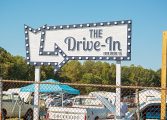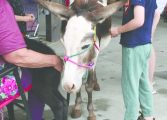After some discussion, Sylvia was offered the editorship of a magazine the other man would initially bankroll.
Sylvia used his journalism background to edit what was initially supposed to be a simple price guide to Civil War relics, but ultimately became North South Trader’s Civil War, a magazine he has been editing and publishing for more than 40 years.
“I put together a staff who read a lot,” those who hunt relics and collect Civil War relics, Sylvia said. “One was a history major at Washington and Lee.” The magazine was well-received, in part because it filled a niche. It was virtually unique in its focus and content.
Throughout his life, Sylvia has been fascinated with the hunt, scouring battlefields and encampment sites with a metal detector, a passion that brought him to central Virginia often.
“After about five years I decided to quit the music business and moved down to Orange, because I loved it down here.
“I fell in love with the town, the people, the countryside. It’s like Andy Hardy here. People didn’t lock their doors. Everyone held doors and said hello. It just blew me away,” he said, looking out the front window of his shop, J.S. Mosby Antiques and Artifacts, onto East Main Street.
In particular, the Trevilians battlefield between Gordonsville and Louisa attracted him to the area surrounding Orange. An older digger took him to the site in 1971.
“He may have been the first guy with a metal detector at Trevilians,” Sylvia said with a combination of excitement and a bit of envy in his voice. “He described still seeing some stuff right on the surface, just under some leaves, ramrods still stuck in the ground.”
Sylvia threw himself into the work, wandering the battlefield and listening for beeps and tones from his detector.
“I remember finding a skirmish line in the woods,” he said, putting together a scene that occurred more than a century before by the patterns and location of artifacts his trowel brought to light.
“Shell casings from a Spencer rifle, the standard Yankee carbine. And, here and there a dropped one,” he said. The things were scattered in a rough line the entire length of a ridge.
“It took me hours,” he said with excitement. “These guys were shooting there.”
A quick survey of the terrain in front took him across a ravine to where he found a similar line dotted with Confederate bullets – there since the 1864 battle.
“I thought, ‘Geez, no one’s ever been on this spot with a metal detector!’” he said.
But the day was waning, and he had to find his way out again. That was before anyone had GPS software on their phones.
“I was never able to find that spot again,” he said. In the interim, the focus of the magazine was refined. It became targeted to collectors and “diggers,” not just as a guide for buyers.
“I didn’t like the idea of prices,” he said. “If we put prices in the articles it’s going to limit the value of the magazine, because you’ll have prices that are no longer germaine two years from now.
“We did six issues a year and the last issue would be a price guide,” he said. Now, four decades later, North South Trader’s Civil War, or “the magazine for collectors and historians,” is in full color and printed on heavy, glossy paper to enhance the presentation of weaponry and preserved uniforms.
In addition to the magazine, Sylvia has written about a half-dozen books on the history of that great conflict and ghost-wrote a book on the “Flying Tigers,” the First American Volunteer Group (AVG) of the Chinese Air Force in 1941–1942. The Flying Tigers was composed of pilots from the United States Army Air Corps, Navy, and Marine Corps.
The effort gave him the chance to interview Gregory “Pappy” Boyington, the American ace and Medal of Honor winner, who was probably best known among the AVG pilots because of his exploits.
His experiences and his research over the years have made him an expert on Civil War relics and collectables.
And, while militaria from other wars is widely sought after and prized, it is the stuff from the Civil War that seems to capture a sense of romanticism and awe as well as controversy that even today bubbles up in our society.
“It was the real final war to create America,” Sylvia opined. “They had been trying since the Revolutionary War to define what comprises the United States. And despite what all these people say, states’ rights was an issue that dated to the Continental Congress.
“That was the biggest problem they had. They had one economy that was 150 percent different from the economy of another colony, and those colonies looked at each other almost as little individual countries, jealous of one another and suspicious of one another.
“All those differences they had to overcome, which wasn’t really resolved until the Civil War,” he said.
“It was fascinating. It really is what defined America.
“There was the element too that it also put an end to slavery in this idealistic nation, the one thing that was at odds with our very idealist founding.
“I think all of that combines.”
And, the fascination with the Civil War and its artifacts isn’t limited to America. There are collectors all over the world who “want a tangible thing to connect with it,” he said.
The recent events in Charlottesville and other cities in the South grappling with the existence of monuments devoted to Confederate soldiers and commanders in the 21st century prove that the terrible conflict that occurred more than 150 years ago can still be a touchstone for debate and anger.
“I think the whole world is watching this thing with the statues with the same sort of mixed emotions,” he said.
He worries that in the debate over the relevancy or the perceived message of those statues, that history is lost or warped though misinformation or disinformation. He noted that while those statues portray the commanders who served under the Stars and Bars, many of them had also served under the Stars and Stripes.
And, when one side or the other on any issue slides into the realm of extremism, they legitimize the claims and fears of the other side, he said.
His appreciation for the history and his accumulated knowledge about the tangible things that represent America’s wars are what connected Sylvia to Antiques Roadshow. When PBS decided to do an American version of the show 21 years ago – the idea had already been established in Britain – they contacted a rather well-known Civil War artist and asked him for leads, Sylvia said.
The artist called Sylvia, who had already established a reputation in the field of weapons and militaria.
He was incredulous. “I said, ‘A show appraising Civil War stuff, antiques?’” he sniffed. “So, I passed on it, and in a few years I discovered, boy, did I make a mistake.”
He finally connected with the show during a taping in Richmond. Sylvia volunteered to play an off-camera role as one of those experts who waded through the hundreds or thousands of pieces brought to be appraised.
“A friend of mine who was an appraiser invited me when they came to Richmond in the late ‘90s and asked if I’d be a guest appraiser.”
The local appraisers didn’t get any TV time, but they’d help with the crush of people hauling their treasures to find out if they were really treasures.
“It was a blast,” he said. “They were interested in really rare stuff, very believable fakes, or a combination of either of those with a really interesting person.
“You don’t get paid or any of your expenses paid. Your remuneration is your exposure on national television.”
He explained that if someone had something particularly interesting and was interesting to talk to, he would summon a runner to offer the article and its owner up for an on-camera interview.
Since then, Sylvia has graduated to an on-air role and has traveled with Roadshow to a number of locations around the country.
Still, most days find him in his shop on West Main Street in Orange, surrounded by the ghosts of those who helped define America with their blood, sweat and tears, the uniforms they wore, the things they carried into battle.
Those things still talk to us in muted voices, the voices of common soldiers and stately commanders. They can be heard in the name roughly carved in a wooden chest, or the wooden buttons that once held together a uniform when brass wasn’t available.




